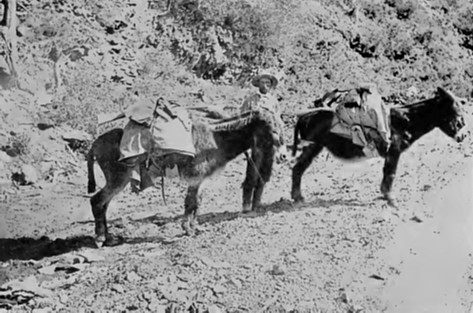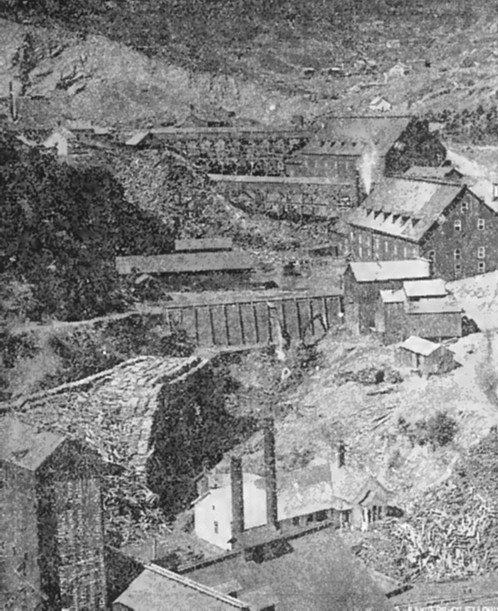Professor Hofman has figured at length the value, after the free gold has been extracted, of the concentrates at the Homestake. The value of the Caledonia concentrates, which are now being saved, are even greater. The following well-known, but now un worked mine, was investigated with the following result: Large quantities of ore are exposed in this mine, which has been worked intermittently as a free-gold property, for the past seven or eight years. After the free gold was extracted, I found the ore yielded 10 per cent of concentrates, which averaged $17.00 in gold per ton. The free gold saved has paid for all development and running expenses. The amount received from the concentrates, after deducting the cost of chlorination, should be clear profit. From a careful survey and examination, I estimated that the opening of another level would add $300,000 to the amount of ore in sight, one-third of which should be clear profit. It is the intention of the School of Mines management to devote the coming season to the further survey and study of the deposits of this class. I am satisfied, from the work of the past seasons, that these ores will pay to work in the manner indicated, viz., by concentration and chlorination, and upon a scale at present little imagined. The enormous quantities in which they are found may entitle them to rank with the great mines of the country, such as the Lake Superior copper mines or the Homestake enterprises.
Segregated Quartz Veins.
Besides those already described, there are numerous gold-bearing
quartz veins parallel to the
bedding, which may be called segregated veins. The gold is accompanied by
little or no sulphides, but occurs free in a vitreous quartz, often in quite
large pieces. Four men without capital have with a small 5
stamp mill operated a vein of this
sort during the past year, with excellent results. They estimate that the
four worked 89 days each, equal to 356 days' labor; this, at $3.00 per day,
$1,068. They have had eight "clean-ups," which netted them $3,383, leaving a
handsome profit of $2,315. Average samples of their ore
assayed at the School of Mines $2.75.
I have mentioned only a few of the more prominent gold mines of the Hills, for it is not the object of this paper to mention particular mining enterprises further than is necessary to show the character of the Black Hills deposits. The thorough study of any one large deposit would easily consume a whole season's work. For this reason, no mention has been made of the Lookout, Uncle Sam, Gregg mines or many others that would seem to require especial mention. There is room yet for the investment of much capital in gold quartz milling enterprises, in both the free-milling and refractory classes of ores here described.
CONTACT DEPOSITS.
General Description and Extent. These include the deposits found in the
Palaeozoic rocks in Ruby Basin and Bald Mountain, at Galena and
Carbonate. The former are mainly gold-bearing, while the latter yield
silver ore and lead. They cover a large area—larger, as I
shall presently indicate, than is generally supposed — and must soon become
important ore-producers. The ore bodies are not continuous, but occur in
shoots. In the first-mentioned districts the shoots have great linear
extent, and are usually from 40 to 60 feet wide, and while some are less
than this, others again are greater. They vary in thickness from a few
inches to ten feet or more. Many hundreds of claims showing
galena have been staked and
recorded. The value of the ore varies. Some of the ore bodies will not
average over $15, while others exceed $60 per ton. From $20 to $25 may be
taken as a fair mean. Some idea of the value of a claim covering but a
single shoot for its full length may be had from the following calculation;
Supposing the width to be 40 feet thickness but 2 feet and length 1,500
feet, a shoot should yield about 10,000 tons, which, at the average value of
$25, will yield $250,000 worth of ore. As ore may be found at different
levels or "contacts " in the same claim, and more than one shoot exist at
the same level, this calculation is not intended to show the absolute amount
of ore that may be in any one claim. These ore-bodies are not found
continuous, but should a full claim 1,500 by 300 feet be underlain by a
single sheet of
gold ore but 2 feet in thickness it would yield nearly
$2,000,000.
These mines are about nine miles from the city of Deadwood, at which place a leaching plant for the treatment of these ores is now in process of erection. At Galena the ore-bodies are of equal promise, but of a different character, being silver-lead instead of gold. Two smelters have been erected in the camp and employed from time to time upon these ores, but distance from coke and other supplies has heretofore rendered the smelting expensive; but the near approach of the railroad is believed to have so reduced the cost that the camp will in the future be a steady producer of lead and silver. The value of both of these sections is assured. Inability to publish a map prevents me from showing their extent as I would like ; and while I spent much time in determining it, I must at this time content myself with a preliminary notice of the occurrence of these ores, showing their probable origin and extent. It may be of interest to prospectors and others. These ores are found only in connection with the igneous intrusions. The gold ores are found in the vicinity of Terry's Peak and Bald Mountain, where others of the Potsdam rocks yet remain. The inference is fair that the rocks once connecting these others were also mineral bearing, and that in the Potsdam beneath the yet unremoved Carboniferous beds will be found ores also — at least so far as the igneous intrusions continue. Owing to the durable nature of the upper parts of the Carboniferous limestone, forming, as it does, nearly vertical walls, the underlying Potsdam at its base is usually concealed by a talus, making it difficult to prospect; but by many trips down the almost unexplored canyons south of Spearfish, and east and north of Galena, I was enabled to draw a reasonably sure conclusion that the ore-breaking rocks of these sections have a far greater extent than has yet been suspected.
At Galena, the miner sees only the outcrop of these lead ores. They dip eastward with the inclosing rocks at an angle of about 16° from the horizon. After leaving Bear Butte creek, no other streams cut through to the level of the mineralized portions. The questions then occur. How far will these rocks prove ore-bearing. Would a shaft sunk upon the territory lying between the village of Galena and the plains beyond prove it to be ore-bearing? North and south of Bear Butte Creek, there is an area of nearly fifty square miles where the igneous rocks occur in exactly the same relation to the Potsdam as at Galena. The streams of this area sometimes cut through to the igneous sheets between the Potsdam rocks, enabling one to see this relation, while vertical dikes rise in many places to the surface. I believe that shafts, sunk to the Potsdam anywhere in this section, would be likely to intercept silver ore.
West of Terry's Peak and Bald Mountain, the same condition occurs throughout a much larger area, extending to the Wyoming side of the Hills, where similar ores are known to exist. In this area a number of streams cut through to Archaean. Upon a few of these I found ores similar to those of Bald Mountain and Ruby Basin. Almost any of the small streams, like Cold creek, that flow into Spearfish creek from the east, will show evidence of these deposits, and should be prospected more thoroughly. After a thorough examination, I am convinced that not a tenth of the area in which these ores occur has yet been located. This section as well as that east of Bear Butte, is overlain by the Carboniferous limestone. Where the dikes above referred to cut through this limestone, contact-deposits of a different character occur. They approximate, more or less, a vertical position, and the Iron Hill mine may be taken as a type. The ore-bodies, which consist of galena and cerrusite, the carbonate of lead, the carbonate being clearly derived from galena, are found adjoining the porphyry where it cuts through the limestone. They differ from the ore bodies at Galena in that they are larger, and cut across the bedding, while the former are parallel to it ; but they are none the less contact deposits.
At Iron Hill, the Potsdam rocks can be seen forming the bed of Cold creek, and between them and the Carboniferous limestone, in which the Iron Hill ore-deposit occurs, is an immense horizontal sheet of porphyry, differing in no way in appearance from the vertical dike in the Iron Hill mine. Beneath this sheet, however, the Potsdam rocks are gold-bearing, while the deposits in the immediate overlying limestone are silver and lead bearing. It would seem as though the same sheet had caused in one series of rocks accumulations of gold ore, and in the other accumulations of silver ore. I mention this fact for the bearing it may have upon the manner in which these ore deposits are formed. I shall make a further use of it presently. Dikes, such as the one connected with the Iron Hill deposits, are common in the area east of Galena, and like it, cut through the Carboniferous limestone. Adjoining these dikes, is frequently the " liver-colored rock " which formed the gossan or outcrop of the Iron Hill mine. Samples of rock from these gossans collected by me assayed from three to ten ounces in silver. I hazard the prediction that ore bodies similar to the Iron Hill, will vet be found there, as well as the continuation of the Galena deposits in the Potsdam beneath, of which I have already spoken. Before the overlying rocks had been removed, we may imagine that the Galena and Bald Mountain sections presented the same appearance as these adjoining areas to-day; and had the prospector then been there, he would have seen as little of what lay beneath as he can now see in the area under consideration. Since then, however, the streams have cut through to the Archseau rocks at Galena, laving bare, in their course, the outcrop of the lower Potsdam rocks, enabling us to study the occurrence of ore, from which we should be able to conclude how far the ore-bearing rocks are likely to extend. I venture the opinion that they are co-extensive with the intruded igneous rocks. The matter could probably be settled by drill hole borings, without the expense of a shaft.
Return
to The South Dakota Page:
South Dakota Gold Rush History



